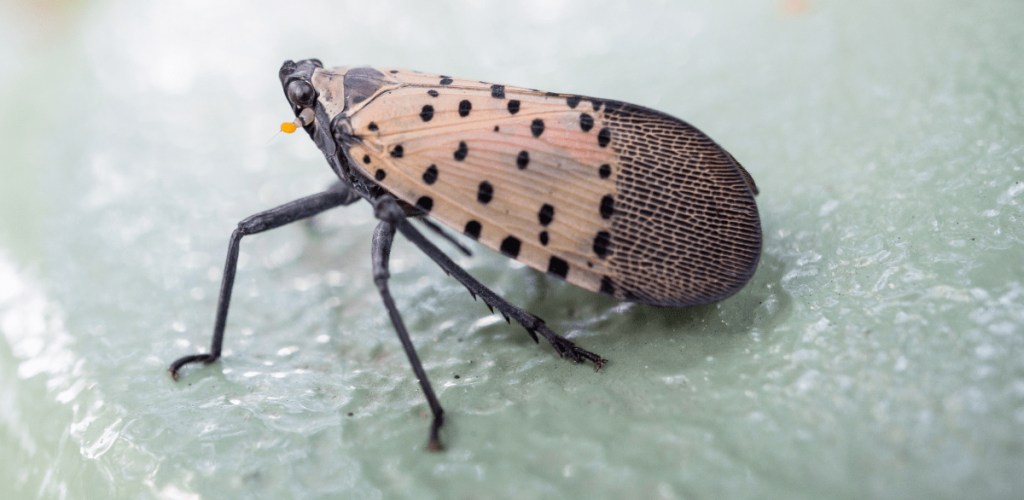Spotted Lanternfly in Connecticut & New York
What you need to know.
The invasive insect species, known as the spotted lanternfly (Lycorma delicatula), has become an increasing concern for property owners in Connecticut and New York. Originally native to Asia, these pests have made their way to the United States and are now wreaking havoc on various crops and trees. However, there are measures homeowners can take to combat their spread. And, Glengate is partnering with clients to answer questions and make effective treatments available. Read on for more information on the impact of spotted lanternfly infestations on properties in Connecticut and New York, along with how we can all work together to lessen the spread.
The Threat of Spotted Lanternfly

The spotted lanternfly poses a significant threat to both agriculture and forestry, as these insects feed on the sap of over 70 different plant species, including important crops like grapes, apples, hops, and hardwood trees. By puncturing the plant tissue with their piercing mouthparts, spotted lanternflies drain vital nutrients, weakening plants and potentially causing irreversible damage. This has raised concerns among farmers, orchard growers, and homeowners alike.
Recent Sightings and Expansion
Originally discovered in Pennsylvania in 2014, the spotted lanternfly has since spread to neighboring states, including Connecticut and New York. Infestations of these insects have been reported in various counties across both states, prompting local authorities to raise awareness and implement control measures. But, homeowners in affected areas need to be vigilant and proactive in combatting the spread of spotted lanternflies, as well.
Identifying the Spotted Lanternfly
The spotted lanternfly can be identified by several distinctive characteristics. In its nymph stage, it appears black with white spots and develops red patches as it matures into an adult. Its distinctive feature is its hind wings, which display bright red and black markings, resembling a colorful mosaic when fully open. These unique attributes make identification relatively easy, helping residents to spot and report the presence of these insects.
Preventing and Controlling Infestations

To prevent the spread of spotted lanternflies, homeowners can take several measures:
Inspect and Report
Regularly inspect your property, including trees, outdoor furniture, and vehicles, for the presence of spotted lanternflies. If spotted, report the sighting to your local authority or agricultural extension service.
Remove Egg Masses
Female spotted lanternflies lay their eggs in large clusters on smooth surfaces like tree trunks, outdoor furniture, or vehicles. Carefully scrape off and destroy these egg masses to prevent hatching.
Plant Selection
Choose plant species that are less susceptible to spotted lanternflies. Working with local agricultural extension services can provide valuable guidance.
Remove Tree of Heaven
This highly invasive tree (Ailanthus altissima) is a preferred host to spotted lanternfly and is now common to our Northeastern landscapes; it’s often seen in disturbed areas such as roadsides. Removing it from our landscapes will help control spotted lanternfly populations.
The increasing presence of spotted lanternflies in Connecticut and New York demands swift action from homeowners to prevent and control infestations. Recognizing the distinctive features of these invasive insects and implementing preventive measures are essential steps. To protect our crops and trees, it is crucial for residents to stay informed, collaborate with local authorities, and take the necessary steps to mitigate the impact of the spotted lanternfly threat.
By working together, we can minimize the spread of this destructive insect, preserving the beauty and health of our natural environment and agricultural landscapes in Connecticut and New York.
Glengate's Commitment

While spotted lanternfly has established populations in other states, it is still new to Connecticut and New York. Over the coming months, Glengate’s in-house experts will be working hard to ensure we know all there is to know.
We specialize in the treatment of ornamental trees, shrubs, and shade tree trunks up to sixteen feet in height, located on your main property.
Our treatment is designed to help control the population and reduce the lanternfly’s impact. It’s important to note, however, that it does not repel these pests, but kills them on contact. Spotted lanternfly has the tendency to reappear regularly, so while our treatment cannot guarantee a completely lanternfly-free property, we’ll work hard to make sure that these pests do not become a major nuisance.




